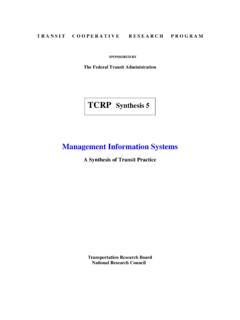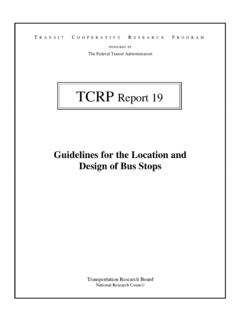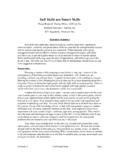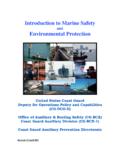Transcription of Chapter 18: Safety and Security - Hudson Tunnel Project
1 Chapter 18: Safety and Security INTRODUCTION. This Chapter describes the conceptual design and approach for incorporating Safety and Security measures into the design of the Preferred Alternative. During final design, construction, Project commissioning, and startup, detailed Safety and Security analyses will continue to be developed. This analysis identifies existing system Safety - and Security -related requirements, policies, procedures, protocols, and infrastructure and identifies those elements proposed to be added. This Chapter contains the following sections: Introduction Analysis Methodology Regulatory Context Analysis Techniques Study Area Affected Environment: Existing Conditions Affected Environment: Future Conditions Impacts of No Action Alternative Construction Impacts of the Preferred Alternative Permanent Impacts of the Preferred Alternative Measures to Avoid, MInimize, and Mitigate Impacts ANALYSIS METHODOLOGY.
2 During development of this Environmental Impact Statement (EIS), the Federal Railroad Administration (FRA) and NJ TRANSIT developed methodologies for evaluating the potential effects of the Hudson Tunnel Project in coordination with the Project 's Cooperating and Participating Agencies ( , agencies with a permitting or review role for the Project ). The methodologies used for analysis of Safety and Security are summarized in this Chapter . REGULATORY CONTEXT. Amtrak and NJ TRANSIT rail operations on the Northeast Corridor (NEC) in the Project area are regulated and/or monitored by Federal, state, and local agencies, including the FRA, Federal Transit Administration (FTA), New Jersey Department of Transportation (NJDOT), New York State Department of Transportation (NYSDOT), and Federal, state, and local law enforcement.
3 The National Railroad Passenger Corporation (Amtrak) is responsible for assessing and implementing Safety and Security measures for the NEC and its trains in the study area. NJ TRANSIT, in collaboration with Amtrak, is responsible for assessing and implementing Safety and Security measures for its trains in the study area. 1. FRA has established regulations related to passenger train emergency preparedness, which have all been directly considered in the design development of the Preferred Alternative. 1. 49 CFR Part 239. Draft EIS and Draft Section 4(f) Evaluation 18-1 June 2017. In addition, other governmental agencies and industry organizations provide Safety and Security related regulations, criteria and guidance for infrastructure design and operations.
4 While not exhaustive, the following is a list of relevant agencies and organizations: American National Standards Institute (ANSI);. American Public Transportation Association (APTA);. American Society of Civil Engineers (ASCE);. Federal Department of Homeland Security (DHS) including Transportation Security Administration (TSA), DHS Protective Security Coordination Division, DHS Office of Cyber and Infrastructure Analysis, DHS National Infrastructure Simulation and Analysis Center, and DHS Science and Technology;. The Federal Occupational Health and Safety Agency (OSHA);. FRA (FRA guidance includes, but is not limited to Emergency Preparedness Guidelines for Passenger Trains, and standards for design, maintenance, inspection, and operations of railroads).
5 FTA (FTA guidance includes, but is not limited to, the Transit Security Handbook, Public Transportation System Security and Emergency Preparedness Guide, and Safety Certification Handbook); and National Fire Protection Association (NFPA); and United States Coast Guard (USCG). The USCG reserves a Security zone in all waters within 25 yards of critical Project structures, such as ventilation facilities. However, none of the Preferred Alternative's critical structures, including the new ventilation facilities, would be within 25 yards of the water; therefore, this does not apply. Among the NFPA standards that apply to the Preferred Alternative is the NFPA Standard for Fixed Guideway Transit and Passenger Rail Systems (NFPA 130).
6 NFPA 130 specifies the latest fire protection and life Safety requirements for underground, surface, and elevated fixed guideway transit and passenger rail systems. NFPA 130 identifies numerous factors, including emergency ventilation, emergency exits, walkways to evacuate a train, access to the nearest position of Safety , and fire standpipe systems. ANALYSIS TECHNIQUES. This analysis identifies existing system Safety - and Security -related requirements, policies, procedures, protocols, and infrastructure and identifies elements that would be incorporated into the Preferred Alternative to address fire-life Safety and Security in compliance with all applicable Federal, state, and local regulations.
7 The analysis also identifies potential impacts and benefits of the Safety and Security elements that would be components of the Preferred Alternative. STUDY AREA. The study area for this analysis is the Project site itself, as defined in Chapter 4, Analysis Framework.. AFFECTED ENVIRONMENT: EXISTING CONDITIONS. Amtrak maintains the NEC and the North River Tunnel in accordance with FRA regulations and requirements as well as other applicable Federal regulations. Among the FRA regulations are requirements for inspection of tracks, signals, bridges, and rail equipment. Amtrak's capital June 2017 18-2 Draft EIS and Draft Section 4(f) Evaluation Chapter 18: Safety and Security program includes required upgrades to operating systems, such as the provision of a Positive Train Control signaling system in the study area as mandated by the Rail Safety Improvement Act of 2008; such a system is currently in place in the North River Tunnel .
8 NJ TRANSIT adheres to the same requirements as Amtrak for its rail equipment that operates on the NEC to and from Penn Station New York (PSNY). NJ TRANSIT and Amtrak provide operating crews with Security awareness training related to Security along the NEC right-of-way. Both organizations have policies and protocols in place to react to Security threats and emergency situations, including alternative service plans for the NEC if trains are unable to operate through the North River Tunnel or into PSNY. NJ TRANSIT, the Port Authority of New York & New Jersey (PANYNJ), and Amtrak work together to coordinate their approach to Security threats and emergencies.
9 The Penn Station Security Task Force (PSSTF) assesses threats and vulnerabilities at PSNY, conducts drills regularly, and coordinates Safety and Security activities of the various railroads that use PSNY. The Fire Life Safety Committee ensures appropriate coordination among emergency responders and agencies within PSNY. AFFECTED ENVIRONMENT: FUTURE CONDITIONS. Under future conditions, existing Safety and Security measures and procedures would continue to be in place and continued maintenance would be conducted and repairs made in the North River Tunnel to assure continued safe operations. The PSSTF will continue to assess threats and vulnerabilities at PSNY, conduct drills, and coordinate Safety and Security activities of the various stakeholders operating within PSNY: the operating railroads (Amtrak, Long Island Rail Road (LIRR), NJ TRANSIT) and their police and Security forces including Metropolitan Transportation Authority (MTA) Police, NJ TRANSIT.
10 Police, the New York City Police Department, tenants in PSNY, and Madison Square Garden. The Amtrak Fire Safety and Security Manager assigned to PSNY and the New York Tunnel system leads the Tunnel Life Safety Task Force Emergency Response Committee activity, and coordinates those committee meetings. The Life Safety Task Force Emergency Response 2. Committee (ERC) will continue to provide coordination among emergency responders and agencies. In addition, Amtrak is currently undertaking an inventory of the intrusion Security systems, with the purpose of aligning these systems among the different passenger rail carriers, as part of a separate Project .










